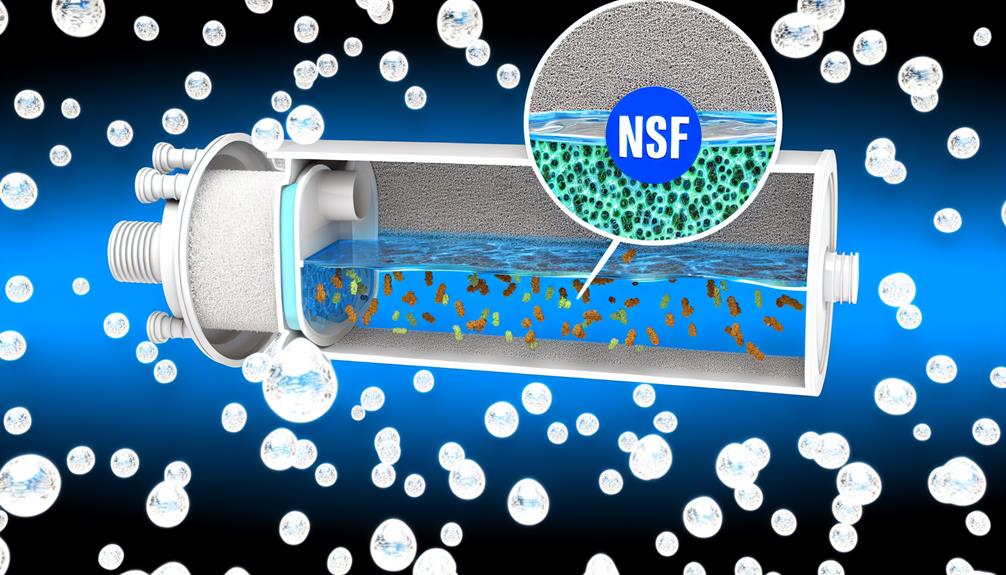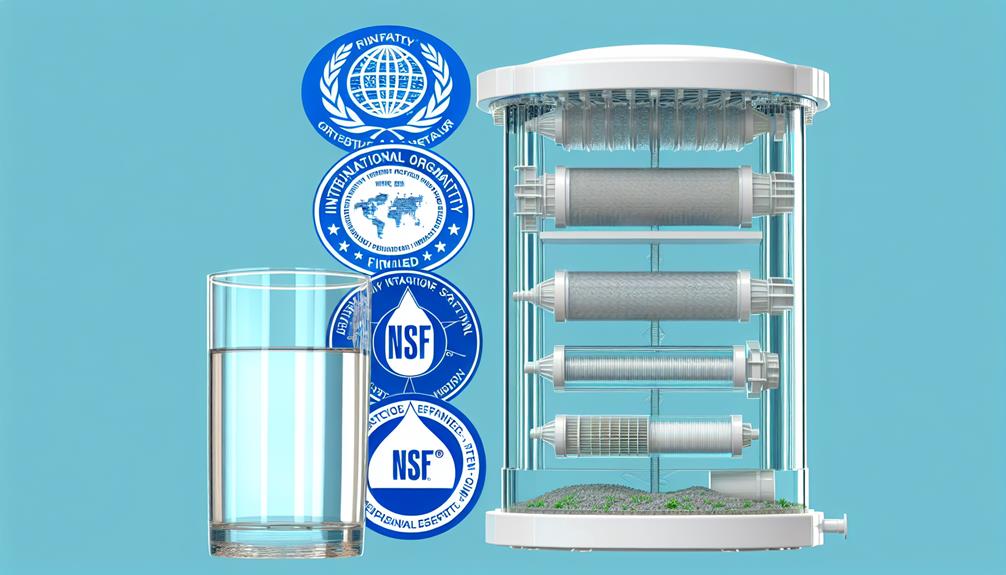You might think that understanding the intricacies of EU water filter compliance standards is a task best left to experts, but it's crucial for you as a manufacturer or distributor to grasp these essentials.
These seven key standards are not just bureaucratic red tape; they're a testament to your commitment to quality and consumer safety.
By aligning your products with these regulations, you not only ensure market access but also build trust with your customers.
As you navigate through the complexities of CE Marking, the Drinking Water Directive, and the REACH Regulation, you'll discover how each standard plays a pivotal role in shaping the water filtration landscape across Europe.
And while these guidelines might appear daunting at first glance, they provide a clear roadmap to delivering products that meet the highest standards of safety and performance.
Stay with me, and we'll explore why mastering these standards could be the linchpin for your business's success in the European market.
Understanding CE Marking
Grasping the importance of CE marking is essential for manufacturers who aim to distribute water filters within the European Economic Area. This mark signifies their product's adherence to the stringent EU health and safety regulations. It indicates compliance with EU legislation, ensuring that your drinking water filter meets the standards for drinking water as outlined by the relevant directives. This mark isn't just a formality but a declaration that your water filtration products conform to the necessary EU health and safety standards, which include managing contaminants and safeguarding water quality and food.
Your understanding of CE marking needs to be as precise and reliable as the drinking water treatment products you provide. Remember, it's not just about meeting minimum standards; it's about ensuring the safety and performance of your drinking water systems. While NSF certification is often sought after in the United States in accordance with the United States Environmental Protection Agency (EPA) and the Safe Drinking Water Act, in Europe, CE marking is your key to market access.
It's your responsibility to carry out and document the conformity assessment procedures, demonstrating that your products are up to par with EU expectations. Non-compliance isn't an option if you're serious about the integrity and success of your product in the European market.
Drinking Water Directive Parameters
Having established the significance of CE marking for water filters, let's now examine the specific parameters set forth by the EU Drinking Water Directive that your products must meet.
The European Union's commitment to public health and safety is reflected in the stringent compliance standards outlined in the directive. As a manufacturer within the water industry, it's crucial to align your performance claims with these parameters, which are grounded in comprehensive scientific assessment.
Here are the key aspects you need to consider:
- Microbiological Parameters: Ensure your filters eliminate harmful bacteria and viruses to safeguard against health effects related to microbial contaminants.
- Chemical Parameters: Filters must effectively reduce hazardous chemicals, including disinfection byproducts, to meet the revised chemical safety standards.
- Indicator Parameters: These parameters, including turbidity, are critical in assessing the overall effectiveness and performance of your water filtration system.
- Testing and Monitoring: Partner with a certified testing organization to conduct regular testing, ensuring ongoing compliance and adaptation to any updates in the standards.
Ingrain these criteria into your quality assurance processes to maintain compliance and protect the integrity of drinking water. Your adherence to these standards isn't just a regulatory formality but a tangible contribution to the collective effort in safeguarding public health.
REACH Regulation Compliance
As you navigate the complexities of REACH Regulation Compliance, it's crucial to grasp the substance registration process to ensure your water filters meet EU standards.
You'll need to meticulously review the chemicals restriction overview, as any non-compliance could lead to significant market barriers.
Additionally, maintaining precise compliance documentation is paramount for both demonstrating compliance and facilitating potential audits.
Substance Registration Process
To comply with the European Union's REACH regulation, manufacturers and importers must register substances used in their water filters with the European Chemicals Agency (ECHA). This registration process is critical and requires a meticulous approach.
Consider the following steps:
- Identify substances in water filters that fall under REACH scope.
- Compile detailed data on each substance's properties and potential health impacts.
- Conduct material extraction testing where required, ensuring systems designed for TDS reduction meet standard protocols.
- Submit a comprehensive dossier to ECHA, including information from testing organization for products.
Components certified to meet NSF/ANSI Standard 61 undergo rigorous material extraction testing conducted by a recognized certification and testing organization. Notably, NSF/ANSI Standard 58 includes material requirements specific to reverse osmosis systems, while NSF/ANSI Standard 61 applies to all products that come into contact with drinking water.
Chemicals Restriction Overview
Building on the steps for substance registration, it's crucial for manufacturers to grasp the breadth of chemicals restrictions when aligning water filters with REACH Regulation compliance. You must ensure that filters don't leach hazardous contaminants, including disinfection byproducts, into drinking water to protect consumers. REACH compliance entails the reduction of specific contaminants and adherence to set national standards.
Your water filtration products, especially systems designed for TDS reduction, must align with established benchmarks. Standard 62 includes material safety criteria; Standard 58 establishes minimum performance requirements, while Standard 55 sets the baseline for UV disinfection efficacy.
When making additional contaminant reduction claims, it's vital to substantiate them within the framework of REACH Regulation to maintain market access and consumer trust in the EU.
Compliance Documentation Requirements
Navigating the REACH Regulation requires manufacturers to meticulously document all chemical substances in their water filters, detailing their impact on health and the environment. To ensure your product complies with national and international standards, you must follow these compliance documentation requirements:
- Substance Identification: Provide detailed information on the chemical properties and uses of substances in your filters.
- Risk Assessment: Conduct comprehensive testing to evaluate the potential hazards and exposure scenarios associated with your product.
- Risk Management: Implement measures to mitigate any identified risks, ensuring material safety and public health protection.
- Registration Dossier: Submit a thorough dossier to ECHA, including NSF product certification if applicable, and data on the hazardous nature of substances as per Standard 61.
Certified compliance shields your product from market restrictions and underscores your commitment to consumer safety.
WFD Ecological Standards
Ensuring the vitality of Europe's aquatic environments, the WFD Ecological Standards require EU member states to rigorously monitor and enhance the ecological quality of their water bodies. These comprehensive standards are pivotal in guiding water treatment processes, including the use of water filters and systems employing reverse osmosis at the point of use.
Ground water and surface waters alike are assessed for their ecological status, taking into account biological, hydromorphological, physical, and chemical conditions, which include monitoring for disinfection byproducts.
Your adherence to these standards ensures that the water treatment methodologies you implement not only meet the required disinfection efficacy but also protect the biodiversity and ecosystems. The reduction of cysts, a key water quality indicator, is a metric of your system's performance. Similarly, UV performance in water filters is scrutinized to verify that it aligns with the WFD's ecological objectives.
As a stakeholder in the EU's water industry, it's critical to understand that the WFD Ecological Standards aren't merely suggestions but mandates designed to safeguard aquatic health. By complying with these directives, you contribute to the sustainable management and protection of Europe's water resources, upholding both environmental integrity and public trust.
EU RoHS Directive
Under the EU RoHS Directive, you must ensure that water filter components adhere to strict restrictions on the use of certain hazardous substances in electrical and electronic equipment. Your compliance is essential for the distribution of safe and environmentally friendly water filtration products within the EU market.
To align with RoHS requirements, consider the following:
- Standard 61: It refers to material safety within drinking water system components. You'll need to verify that materials in contact with drinking water meet these standards to avoid leaching of harmful substances.
- Standard 55: This standard is vital for systems utilizing ultraviolet (UV) light. Your product's UV components shouldn't contain RoHS-restricted substances that could compromise the safety and efficacy of the disinfection process.
- Standard 62: Compliance with this standard ensures that chemical additives, including disinfection byproducts, are within safe limits. Regular testing conducted for municipal drinking water systems will help identify any deviations from RoHS directives.
To maintain compliance, you'll need to conduct thorough material safety assessments and ensure that any electrical elements, especially those in contact with water, don't release hazardous substances. This vigilance protects consumers and the environment from potential chemical contamination.
EN Standards Alignment
Aligning your water filter products with EN standards is a crucial step in demonstrating their compliance with European safety and performance benchmarks.
Specifically, adherence to Standard 61 ensures material safety, guaranteeing components that come into contact with drinking water don't leach harmful substances. Similarly, Standard 44 addresses water softeners, focusing on their efficiency in ion exchange and regeneration.
To mitigate disinfection byproducts, Standard 55 is of paramount importance for water treatment devices using ultraviolet (UV) technologies. This standard prescribes strict protocols for the elimination of microorganisms without introducing hazardous residues. Furthermore, Standard 62 pertains to drinking water distillation systems, setting forth specifications that ensure the effective removal of contaminants.
For POU reverse osmosis systems, which are integral for total dissolved solids (TDS) reduction, compliance with designated EN standards is non-negotiable. These standards dictate rigorous performance criteria, including the percentage of TDS reduction, system integrity, and the purity level of the filtered water.
TÜV SÜD Certification
While adhering to EN standards is fundamental for your water filter's market readiness, obtaining TÜV SÜD Certification elevates the product's compliance to encompass broader European legislative benchmarks. You'll appreciate that this certification isn't just a rubber stamp; it's a rigorous process ensuring your water filter meets high safety and performance criteria.
Here's what TÜV SÜD Certification signifies for your water filter product:
- Compliance with Council Directive 98/83/EC, which states the water quality parameters applicable to water treatment for human consumption.
- Alignment with Commission Directive (EU) 2015/1787, ensuring your product helps reduce contaminants from a known source to safe levels.
- Assurance that your product has been tested and certified to meet or exceed NSF/ANSI Standard 61 typically required for materials that come into contact with drinking water.
- Certification of POU (point-of-use) reverse osmosis systems designed for TDS (total dissolved solids) reduction, confirming Standard 55 includes material requirements and performance measures for UV microbiological water treatment systems.
TÜV SÜD's seal of approval means that your water filter product has been scrupulously evaluated against these standards. This is critical for maintaining trust with your customers, who rely on you for the quality and safety of their water usage.

